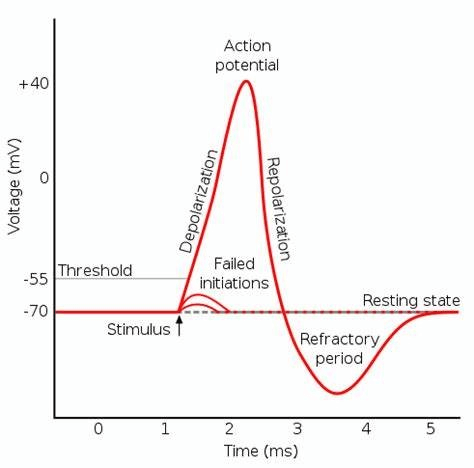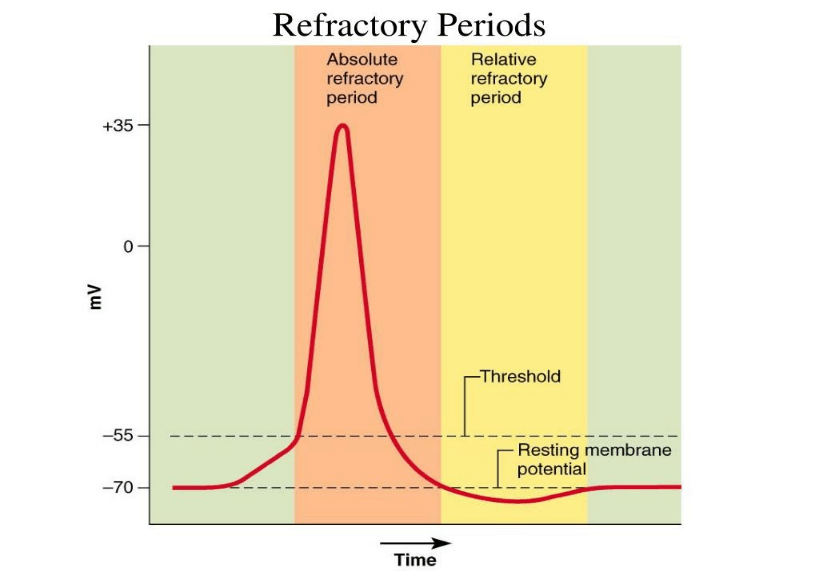Action Potential DefinitionThe nervous system relies on the rapid transmission of signals between neurons to allow for communication and coordinated responses to external stimuli. One critical component of this process is the action potential, a brief but powerful electrical impulse that travels along the membrane of a neuron or muscle cell. In this article, we will explore the definition of an action potential, the processes that occur during an action potential, and the importance of action potentials in communication between neurons and the transmission of signals throughout the nervous system. Additionally, we will examine the medical implications of action potentials, including their role in the diagnosis and treatment of neurological disorders. 
Defining Action PotentialAn action potential is a swift, transient electrical impulse that travels over the membrane of a neuron or muscle cell. It is generated by the movement of charged ions across the cell membrane, which causes a change in the electrical charge of the cell. Action potentials are produced by the depolarization and repolarization of the cell membrane, which happens as a result of ion channels opening and shutting. The cell membrane is electrically charged negatively on the inside and positively on the outside while it is at rest. When a stimulus, such as a neurotransmitter or sensory input, is received, ion channels in the cell membrane open, allowing positively charged ions, such as sodium, to enter the cell. This influx of positive ions causes the electrical charge inside the cell to become less negative, or depolarized. If the depolarization reaches a threshold level, it triggers the opening of more ion channels and a massive influx of sodium ions, causing rapid depolarization of the cell membrane. This rapid depolarization is the action potential. After the peak of the action potential, ion channels close, and the cell membrane repolarizes, returning to its resting state. Action potentials are necessary for signal transmission throughout the nervous system and for interaction between neurons. The frequency and speed of action potentials can vary depending on various factors, such as the diameter of the axon (part of the neuron) and the myelination of the cell membrane. A typical example of an action potential can be seen when a person smells a scent or odour. In that case, olfactory neurons in the nose usually fire action potentials as a response. It shows that the action potential is the result of a stimulus. They are triggered by a stimulus that results in a change in ion concentration inside and outside the cell. Steps InvolvedHere are the steps of depolarization and repolarization during an action potential:
Refractory Period and Its Role in Action PotentialThe refractory period is a period of time following an action potential during which a neuron or muscle cell is unable to generate another action potential, even in response to a strong stimulus. The refractory period is necessary to prevent the overstimulation of cells and to ensure proper transmission of signals in the nervous system. There are two types of refractory periods, namely absolute refractory period and relative refractory period. 
The cell membrane is totally insensitive to any stimulation, regardless of how powerful, during the absolute refractory period, which takes place between the depolarization and repolarization stages of an action potential. This is due to the fact that the ion channels that were open during the depolarization phase are inactivated and cannot be opened again until the cell membrane has repolarized. During the relative refractory period, which occurs after the hyperpolarization phase of an action potential, the cell can respond to a strong stimulus, but only if it is stronger than the threshold level needed to initiate an action potential. This is because the membrane potential is more negative than the resting potential during the relative refractory period, so it takes a stronger stimulus to reach the threshold level. The duration of the refractory period can vary depending on the type of cell and the intensity of the stimulus. In general, the refractory period is shorter in muscle cells than in neurons, allowing for more rapid muscle contractions. Propagation of Action PotentialPropagation of action potential refers to the process by which an action potential travels along the length of an axon or muscle fibre, allowing for communication and signalling throughout the nervous system and muscle tissue. There are two main factors that contribute to the propagation of action potentials: local current flow and the refractory period. When an action potential occurs, the transport of ions across the cell membrane generates a local electrical current that depolarizes the nearby region of the cell membrane. This process is known as local current flow. This depolarization then triggers the opening of ion channels in the adjacent section of the membrane, causing an action potential to occur in that region. This process continues throughout the length of the cell, resulting in the propagation of an action potential. The propagation of action potentials is greatly influenced by the refractory period as well. The portion of the membrane that recently experienced an action potential is unable to produce another action potential during the refractory phase. The action potential can only go in one direction throughout the length of the cell as a result, creating a "one-way street" effect. This guarantees the signal's coordinated and directional transmission. In myelinated neurons, the process of propagation is further facilitated by the presence of nodes of Ranvier, which are small gaps in the myelin sheath that allow for the depolarization of the cell membrane to occur more rapidly. The action potential propagates more quickly as a result of this saltatory conduction, in which it "jumps" from node to node along the myelinated axon. SynapseSynapses are specialised junctions that connect two neurons or a neuron and a target cell, like a muscle or gland cell. It is the site of communication between neurons and allows for the transmission of signals throughout the nervous system. There are two main types of synapses: electrical synapses and chemical synapses. Electrical synapses are rare and involve direct communication between the cytoplasm of adjacent neurons through gap junctions, allowing for the rapid transmission of signals. Chemical synapses, on the other hand, are more common and involve the release of chemical messengers, called neurotransmitters, from the presynaptic neuron into the synaptic cleft, a small gap between the presynaptic and postsynaptic neurons. The neurotransmitters then bind to receptors on the postsynaptic neuron, triggering a response and allowing for the transmission of the signal. The transmission of signals across a synapse involves several key steps. First, an action potential travels down the axon of the presynaptic neuron, causing the release of neurotransmitters into the synaptic cleft. A change in the postsynaptic neuron's membrane potential results from the neurotransmitters' subsequent binding to receptors on that cell. Synaptic inputs to a neuron cause either membrane depolarizing (excitatory) or hyperpolarizing (inhibitory), meaning that they cause membrane potential changes, either increasing or decreasing in the membrane potential as the result of the likelihood that a neuron will fire an action potential. The transmission of signals across a synapse can be modulated by various factors, including the availability and activity of neurotransmitters, the number and sensitivity of receptors, and the activity of other neurons in the network. This allows for the fine-tuning of neural activity and the regulation of complex behaviors. Graded Potentials vs. Action PotentialsGraded potentials and action potentials are two types of electrical signals that occur in neurons, but they differ in their characteristics and functions. Graded potentials are small adjustments in a neuron's membrane potential that happen locally in response to a stimulus. They can be either depolarizing (excitatory) or hyperpolarizing (inhibitory), and their magnitude is proportional to the strength of the stimulus. Graded potentials can summate, meaning that the effects of multiple stimuli can be added together to produce a larger response. Graded potentials are important for signal processing and integration in the dendrites and cell bodies of a neuron. In contrast, action potentials are all-or-nothing electrical signals that occur in response to a depolarizing stimulus that reaches a threshold level. Action potentials normally have a defined magnitude and duration and are characterised by a quick depolarization phase followed by a repolarization phase. They are propagated along the axon of a neuron and allow for long-distance communication between neurons. Action potentials do not summate, meaning that multiple stimuli do not produce a larger response, but rather they have a threshold that must be met to produce a response. The Bottom LineIn conclusion, the action potential is a critical process for the proper function of the nervous system, allowing for the transmission of electrical signals along the axon of a neuron. It is characterized by a series of phases, including depolarization, repolarization, and hyperpolarization, and is mediated by the opening and closing of ion channels. Overall, the action potential is a fundamental process that underlies the functioning of the nervous system, allowing for complex behaviours and processes that are somewhat critical for survival.
Next TopicApomixis Definition
|
 For Videos Join Our Youtube Channel: Join Now
For Videos Join Our Youtube Channel: Join Now
Feedback
- Send your Feedback to [email protected]
Help Others, Please Share










